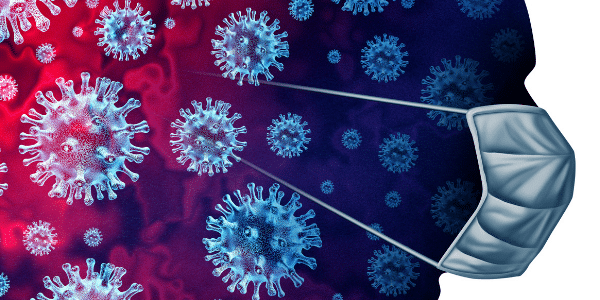With countries experiencing lockdowns and social distancing practices being mandated across the United States, health concerns are at an elevated state as countries race to control the spread of coronavirus, COVID-19.
Coronaviruses (CoV) are a large group of viruses that can cause illness ranging from the common cold to more severe diseases such as Middle East Respiratory Syndrome (MERS-CoV) and Severe Acute Respiratory Syndrome (SARS-CoV).
The newest strain of Coronavirus disease, scientifically known as COVID-19, was officially classified as a pandemic by the World Health Organization (WHO) on Wednesday, March 11, 2020 and continues to spread, posing a threat to individuals around the world.
How is Coronavirus Transmitted?
COVID-19 is transmitted from person to person through small fluid droplets from the nose or mouth of an infected individual from coughing, sneezing and exhaling. These droplets can remain airborne and can land on objects and surfaces. Much is still unknown about the virus’s survivability on various types of surfaces however it is believed to live anywhere from a few hours to a few days. Once the virus is in the air or on a surface it can be picked up by another individual or individuals who breathe in the same air space or touch these surfaces and then touch their eyes, nose or mouth, though the primary means of transmission is through direct contact with respiratory droplets rather than through the air.
Who is At Risk?
The risk for infection depends greatly on an individuals’ location, and more specifically, whether there is a COVID-19 outbreak unfolding there. While those who have contracted the virus range in age and health status, individuals who have been found to be at the greatest risk for developing the most serious symptoms of COVID-19 are older persons and persons with pre-existing medical conditions (such as high blood pressure, heart disease, lung disease, cancer or diabetes) who have respiratory issues or a compromised immune system. Additional risks are among those who have recently traveled from an outbreak area or high-risk areas such as Hubei province, China, Iran or Italy in the last 14 days.
What are the Signs and Symptoms of Coronavirus?
Much like the standard flu, the most common symptoms of coronavirus COVID-19 are fever, tiredness and dry cough. Some patients may even experience aches and pains, nasal congestion, runny nose, sore throat or diarrhea. In some cases, individuals may become infected but not develop any symptoms. While most people infected with COVID-19 recover from the virus without doctor assistance. In 80 percent of known cases, COVID-19 causes mild to moderate illness and symptoms, and according to the report of the WHO-China joint mission, in about one in five patients, the symptoms get worse with about 14 percent of cases becoming severe and 6 percent of cases become critical.
Preventative Measures
To reduce your chances of being infected or spreading coronavirus COVID-19 a number of precautions should be taken. Regularly and thoroughly washing your hands with an alcohol-based hand rub or soap and water should be routine practice as doing so can kill any viruses that may be on your hands from coming in contact with contaminated surfaces.
Practicing social distancing is another preventative measure that should be practiced, avoiding groups of people and maintaining a distance of six feet or more between yourself and anyone who is coughing or sneezing. Additional preventative measures include avoiding touching your eyes, nose and mouth, and following good respiratory hygiene by covering your mouth and nose with your bent elbow or tissue when you cough or sneeze.
It is also essential that individuals who are feeling unwell in any capacity, remain home. If you or a family member within your household have a fever, cough or difficulty breathing, all members of the household should self-quarantine and the infected should seek medical attention if symptoms progress too quickly or cause respiratory issues.
To stay abreast of how you can prevent the spread of coronavirus COVID-19 and avoid catching the virus is to remain aware of the latest information on the COVID-19 outbreak, available on the WHO website or through local public health authority.
What to Do If You Contract the Virus
For those who begin to feel ill, the first necessity is to remain at home. Even if your symptoms are very milk, do not go to work, school or public places to reduce your risk or catching or spreading the virus. Next, be sure to treat your symptoms as you would if it was a standard cold or flu. For a fever, take acetaminophen (Tylenol) or Ibuprofen (Advil). For a cough take Mucinex, Robitussin, DayQuil/NyQuil or whatever your cough medicine of choice is, and take it as directed. If you have a humidifier, use that or sit in a bathroom and breathe in some hot steam for a little bit. If you have a history of asthma, be sure to have your inhaler on hand and use as needed. The key is to stay home, get lots of rest and stay hydrated.
Treatment Options
At this time, while there are some traditional or home remedies that may provide comfort and alleviate COVID-19 symptoms, there are no current medicines or vaccines that can prevent or treat the virus. For those looking for antibiotics it should be noted that antibiotics do not work as they do not fight against viruses, they only work on bacterial infections.
When to Seek Medical Help
The possibility of having a contagious virus is scary, but doctors, nurses and other caregivers are working together with national and international agencies to identify and provide care to patients while avoiding the spread of the illness in the community. It is important to try to stay calm when treating yourself or a loved one and when seeking medical assistance.
If you feel ill and symptoms do not alleviate and you thing you have COVID-19, seek medical attention. Begin by calling your general doctor to seek guidance or call ahead to a nearby clinic or hospital. Medical staff at these offices can help ascertain if you should be seen or should remain in self-quarantine and continue home remedies.
If at any time your fever continues to increase at a steady pace or you begin experiencing respiratory problems, seek out the best available medical clinic or hospital to be checked in to (you may need to call ahead to avoid crowds and wait times).
If you have to leave your home to visit a doctor or hospital be sure to take extra precautionary measures to avoid further spreading the virus. It’s best to go alone to your appointment and not bring children or other family members unless you need assistance or have no other options.
How to Protect Yourself and Others
If you have a mask, wear it to protect others, keep a distance between yourself and others whenever possible and cover your coughs and sneezes with your elbow or a tissue or towel, wash or sanitize your hands frequently. Once you are back home be sure to clean the often-touched surfaces such as doorknobs, cabinets, bathroom hardware, tabletops, phones, keys and keyboards with disinfectant.
Individuals and family members with confirmed COVID-19 should remain under home isolation precautions until the risk of secondary transmission to others is thought to be low. The decision to discontinue home isolation precautions should be made on a case-by-case basis and in consultation with your healthcare provider and local health departments.
In times of infection it is essential to stay informed with state and local updates to understand how to best respond to a viral pandemic. Be sure to watch and follow local news broadcasts, governor press announcements and CDC and WHO updates as they unfold to answer any questions you may have along the way.
While the COVID-19 pandemic can seem scary, practicing preventative measures and making smart decisions based on current and local circumstances can help limit the number of cases and severity of the rate of transmission.





